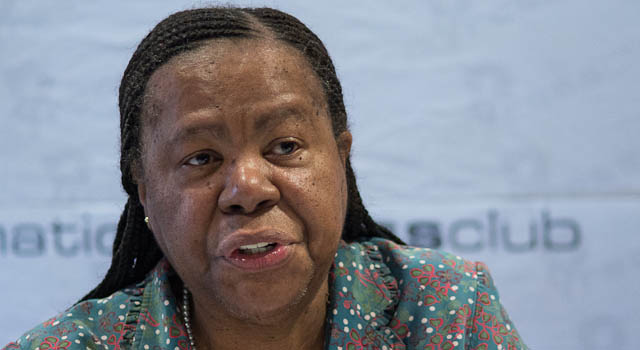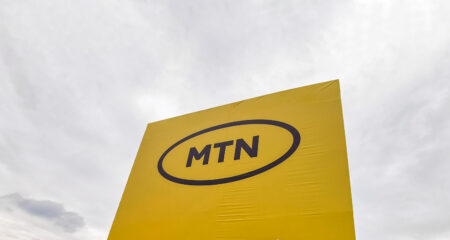
South Africa is making a number of bold moves that could see the country leapfrog into being a leading hydrogen fuel cell technology industrial hub, said minister of science & technology Naledi Pandor.
She was speaking at an event where the University of the Western Cape (UWC) and Impala Platinum unveiled South Africa’s first hydrogen fuel cell forklift and refuelling station.
“That’s what we are here to see,” she Pandor. “A bold move. A forklift may appear to be a small move. But great industries have developed from small moves.”
Fuel cells are a family of technologies that use electrochemical processes rather than combustion to produce power. The technology will significantly enhance ventilation requirements, and reduce heat, noise levels and noxious and sulphide emissions underground.
The metal hydride system brings with it significant benefits.
It allows for the forklift to operate at lower pressures of 180 bars, improving vehicle safety and costs. The cost of the local refuelling station is around R2m vs €500 000 (R8,4m) for an international system.
The forklift also has lower noise levels, and longer operational times between refuelling, ensuring increased productivity — there is sufficient fuel for two to four days before hydrogen refuelling is required, and the refuelling itself takes only seven minutes.
“South Africa is beginning the difficult but important journey towards a hydrogen economy, and this partnership is an important step in that direction,” noted Frans Swanepoel, deputy vice-chancellor: research and innovation at UWC. “If fuel cell forklift development is to take off, it has to happen in South Africa — and UWC is happy to play a part in that.”
The three-year project, which commenced in 2012 was a collaborative effort between Impala Refining Services and Hydrogen South Africa (HySA) Systems, which is hosted by UWC and the department of science & technology.
Over the past three years, Implats provided HySA Systems a total of R6m towards the development of a fuel cell-powered prototype forklift and refuelling station.
A fuel cell forklift prototype has been in operation since October 2015 within the dispatch area at the base metals refinery at Impala Refining Services in Springs. Implats plans to use hydrogen fuel cell technology as its main source of energy for material handling and underground mining equipment.
The initiative involves building local skills in the development of hydrogen and fuel cell products and co-funding the development of the prototype forklift and refuelling station.
This investment is a result of over a decade of continuous discussions and negotiations between Implats and UWC’s South African Institute for Advanced Materials Chemistry (SAIAMC), under the leadership of SAIAMC’s director, Vladimir Linkov.
“With Impala Platinum becoming a partner to SAIAMC, UWC has achieved the long-term goal of entering strategic research, development and innovation partnerships with an absolute national leader in one of the pillars of energy generation for current and future needs of the South African economy,” he said.
“This partnership is unique in the national system of innovation, unparalleled by any other university laboratory or institute in South Africa,” said Linkov.
Fuel cell-powered forklifts are gaining significant traction worldwide and are now entering mainstream commercialisation, said Cordellia Sita, director of HySA Systems.
“However, the limited availability of refuelling infrastructure, coupled with the challenge of finding the most appropriate on-board hydrogen storage technology remains a big challenge. Through this demonstration project, HySA Systems has addressed both challenges through the use of a novel metal hydride material for both hydrogen compression and storage.”
Implats CEO Terence Goodlace said developing a viable fuel cell industry in South Africa has several advantages for the country such as economic development, sustainable job creation and social good.
“As the world’s largest platinum-supplying region there is a guaranteed supply of the metal as well as the potential to increase in global platinum demand,” he said.
Southern Africa is home to around 80% of the world’s platinum resources so the potential for platinum-based fuel cells to drive economic development is enormous.
“The development and implementation of this technology provides an important opportunity for South Africa to play a role in reducing global greenhouse emissions, thus diminishing urban pollutants and contributing to reduced health care costs and an improved quality of life,” added Goodlace.
Over the long term, Implats plans to fast-track local manufacturing of fuel cells and components within a proposed tributary special economic zone in the Springs region.
The company’s longer-term strategic investments include exploring a carbon neutral fuel source for its operations, and participating in collaborative efforts through the Impala Roadmap to develop fuel cell technology to drive knowledge-based skills development and job creation, and to increase foreign direct investment in South Africa.
The fuel cell industry has the potential to revolutionise the way power is delivered to all areas of our lives — from cars to mobile phones and computers, as well as to our homes and workplaces.
Fuel cell technologies have the potential to provide access to affordable, safe, clean and reliable energy. Local fuel cell development also holds the promise of boosting manufacturing capacity and competitiveness in South Africa, where the predominant supply of the critical platinum components is mined.



